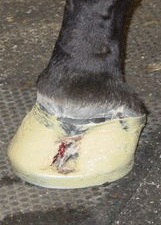 While hoof care should be considered as a necessary part of the daily management of a horse, many of us neglect it and treat it as a time consuming task. Many horse owners even think that hoof care should only be done by their farriers. What we should understand, is healthy hooves require more than just trims and shoes.
While hoof care should be considered as a necessary part of the daily management of a horse, many of us neglect it and treat it as a time consuming task. Many horse owners even think that hoof care should only be done by their farriers. What we should understand, is healthy hooves require more than just trims and shoes.
Get A Good Farrier
It is true that getting help from farriers and veterinarians can improve all domestic horses’ health. A good farrier can inspect the hooves of your horse and recommend the right shoes for it. In determining the type of shoes your horse should get, the farrier will look into various factors such as the place where your horse is stabled, the geography and its activities.
Farriers are skilled in hoof trimming. Trimming should be done regularly, every six weeks or so, as hooves tend to grow a quarter of an inch every month. In addition, trimming is vital as this help the shoes to remain rightly fitted.
While this is the case, acquiring healthy hooves will still require the participation of the horse owner. You must understand that hoof health is influenced by several factors such as environment, nutrition, cleaning as well as injury or wound care and prevention. As you are the best person that can influence the lifestyle of your horse, your contribution can provide a big positive impact on health of your horse’s hooves.
Here are some tips so you can create a hoof care routine:
Thoroughly Clean The Hooves – Use a hoof pick to remove rocks, grass, manure and other dirt. Then, use a stiff-bristle brush to remove debris from the sole. Make it a habit to clean each hoof daily since this will allow you to remove debris that may cause damage or injury. While cleaning, check for signs of cracks, abscesses, thrush and puncture wounds.
Inspect the Shoes – See if the horseshoes are bent or shifted. Wrongly shod hooves can cause injury, so make sure to get help from your farrier if you spot damage on the shoes.
Add Hoof Supplement – Most of these supplements include vitamins and minerals such as biotin and zinc which can help maintain and promote growth of keratin and protein on your horse’s hooves. Make sure to ask your veterinarian for the diet that can provide all your horse’s nutritional needs.
Do Not Let Your Horse Stay On The Mud – Long exposure to mud can change the moisture content, result to thrush or infections and loosen shoes on hoof. Mud can also expose your horse to risk such as slip, fall and leg injury. Prevent flood formation by levelling the pastures and filling up the holes. For extra protection and to prevent infections, use tropical conditioners.
Encourage Exercise – Exercise improves hoof health, strength and growth. There are various activities that can provide the exercise your horse needs such as horse soccer, using the paddock with a lunge line and more.
Moisture Balance – Use a tropical conditioner to control hoof water absorption and loss. Dry and hot weather can make the hoof break, crack and grow weak. Wet weather, muddy paddocks and dewy pastures can allow the hooves to soften. Both weather conditions increase risk of your horse’s hooves to infection and injury so make sure to apply the right moisturizer or sealant.
A soft hoof will have a hard time holding nails, maintaining strength and providing support which is why hoof moisture balance is essential. Too much moisture is far worse compared to a dry hoof. Mostly, hoof products can disrupt the moisture balance of hooves so make sure to use the right amount and product.
Use a sealant if your horse’s hooves are too soft due to excess moisture. For dry hooves, better access to water can help. However, allowing your horse to stand on mud or water and then returning it in the stall with shavings can be very hard on your horse’s hooves. Mainly, daily over moisturizing and drying on the hoof wall can have a bad effect. Most cracks are not due to dry and hard hooves, they are usually due to excessively moist and soft hooves.
Remedial Shoeing
Standard horse shoes are concave and are made from steel. They elevate the frog, allowing the heels to carry more weight. While strong footed horses can handle this, weak footed horses tend to encounter issues no matter how efficient they are shod. Horses with weaker and flat feet as well as collapsed heels can benefit from remedial shoeing such as egg bar and heart-bar shoe since it enhances the ground bearing surface at the heels.
The unshod foot carries the most weight on the hoof wall and frog, while, the sole carrying only minimal weight. The frog has a significant area of ground contact, providing the rear of the foot a bigger overall bearing surface than the area on the toe. The face of the foot tends to wear more than the area on the heel. In order to maintain the right normal axis, a combination of a bigger heel/ground surface and bigger toe wear should be applied.

